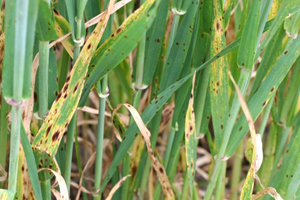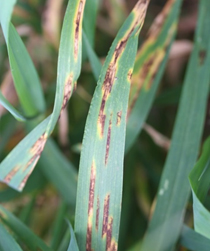Net blotches of barley
Net blotch is a common disease of barley, and is caused by the fungus Pyrenophora teres. It has two forms:
- spot form (SFNB)
- net form (NFNB).
The spot form is more common in Victoria, due to the widespread cultivation of susceptible varieties. The net form is becoming more prevalent due to the increased adoption of susceptible varieties.
Both diseases can be effectively managed by using a combination of varietal selection, crop rotation and fungicides.
What to look for
Spot form of net blotch (SFNB)
Symptoms are most commonly found on leaves, but can occasionally be found on leaf sheaths. They develop as small circular or elliptical dark brown spots becoming surrounded by a chlorotic zone of varying width. These spots do not elongate to the net-like pattern characteristic of the net form. The spots may grow to 3-6 mm in diameter.

Net form of net blotch (NFNB)
The net form of net blotch starts as pinpoint brown lesions, which elongate and produce fine, dark brown streaks along and across the leaf blades, creating a distinctive net-like pattern. Older lesions continue to elongate along leaf veins, and often are surrounded by a yellow margin.

Disease cycle
Initial crop infection (primary inoculum) typically comes from infected stubble, on which the pathogen can survive for up to 3 years.
The NFNB can also be seed-borne following humid conditions while the crop is maturing. Seed infection of SFNB is not regarded as an important source of primary inoculum.
Initial crop infection occurs with approximately 6 hours of moist conditions at temperatures between 10ºC and 25ºC. Primary inoculum is derived from airborne spores, which are ejected up to 40cm from stubble of the previous crop.
The formation and dispersal of secondary inoculum (conidia) takes place between 14 to 20 days after primary infection. The spores are derived from these leaf infections and dispersed by wind and usually travel short distances within the crop, but can also be blown into neighbouring crops.
Secondary infections can occur repeatedly throughout the growing season whenever conditions are favourable. As the barley plant begins to senesce, the fungus grows into the stem and survives on the stubble. In the following season there is a positive relationship between the amount of stubble from the previous crop and the severity of net blotch in the current crop. Thereafter, the stubble continues to produce spores until completely broken down.
Economic importance
The NFNB is less prevalent in Victoria, but can be more damaging. Net blotch can cause a significant increase in screenings leading to downgrading from malting quality as well as reduced yields.
Yield losses from NFNB generally range between 10 and 20 per cent, but losses of more than 30 per cent have been reported.
SFNB, although common early in the season, rarely develops sufficiently in spring to cause significant yield loss. If yield losses do occur from SFNB infection, they generally range between 0 and 10 per cent, but in severe outbreaks can exceed 20 per cent. SFNB more commonly causes reductions to grain quality through reduced grain size.
Management
Both SFNB and NFNB can be effectively controlled with an integrated strategy incorporating varietal selection, crop rotation, seed treatment and crop monitoring with a view to fungicide applications, if required.
Varietal selection
Avoid susceptible (S) and very susceptible (VS) varieties. Consult the Cereal Disease Guide when selecting varieties.
Crop rotation
Avoid growing barley in successive years in the same paddock as most inoculum survives in stubble. Crops located close to infected stubble will receive more inoculum than those more distant. Also, disease levels will be higher in crops in districts where barley crops are grown in close rotation.
Seed dressings
A new seed treatment containing fluxapyroxad (Systiva®) is available for control of both net blotches in barley. Fluxapyroxad is very effective during the emergence and tillering stages of crop development and can provide control into the stem elongation stages.
Ensure that other fungicides are used in rotation with fluxapyroxad as it has a SDHI mode of action which has a high risk of resistance developing in the pathogen.
Time of sowing
Early sowing increases the risk of a net blotch infection. However, sowing later to avoid net blotch should be weighed up against other agronomic factors.
Foliar fungicides
Monitor barley crops and apply a registered foliar fungicide if required.
There are a number of products registered to control the net form and the spot form of net blotch. Check the product label to ensure the fungicide is effective on the form of net blotch you have, and also check withholding periods.
SFNB can cause yield loss where the percentage of leaf area affected is greater than 10 per cent. For best suppression of SFNB using foliar fungicides, apply between the beginning of stem elongation (GS 31) and flag leaf emergence (GS 39). A single application of foliar fungicide may be insufficient to eliminate grain yield and quality loss in some cases and a 2 or 3 application strategy may be warranted.
Growing a variety that is moderately susceptible (MS) or better greatly reduces the likelihood of grain yield and quality loss. Foliar fungicides are less likely to improve grain yield in these varieties and are therefore unlikely to be economical to apply.
In addition, yield improvements are also only likely where the disease is severe and potential yield exceeds 3t/ha.
Further information
- Victorian Cereal Diseases Guide
- Decimal Growth Scales of Cereals
- SARDI Cereal Seed Treatments
- Victorian Winter Crop Summary
Contact
Dr Mark McLean
Cereal Pathologist — Horsham
03 5450 8301
Field Crops Pathology
Grains Innovation Park
110 Natimuk Rd
Horsham 3400
03 5450 8301
Or call the Customer Service Centre, 136 186
Acknowledgments
Mark Mclean, Grant Hollaway and Luise Sigel. Support by the Grains Rersearch and Development Corporation is gratefully acknowledged.